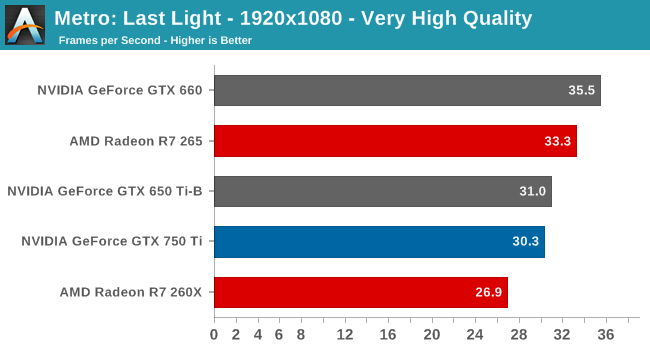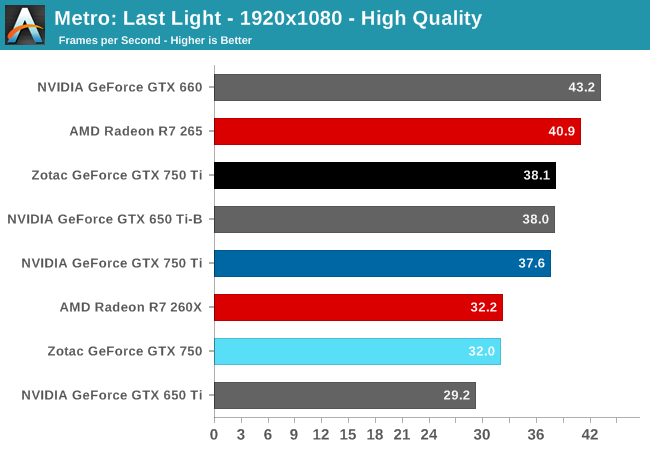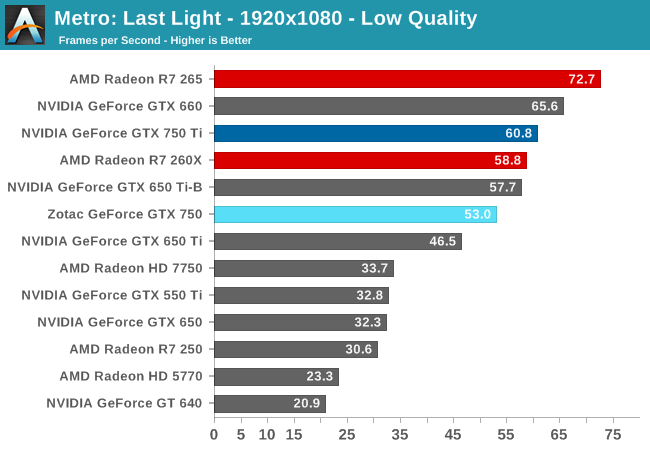The NVIDIA GeForce GTX 750 Ti and GTX 750 Review: Maxwell Makes Its Move
by Ryan Smith & Ganesh T S on February 18, 2014 9:00 AM ESTMetro: Last Light
As always, kicking off our look at performance is 4A Games’ latest entry in their Metro series of subterranean shooters, Metro: Last Light. The original Metro: 2033 was a graphically punishing game for its time and Metro: Last Light is in its own right too. On the other hand it scales well with resolution and quality settings, so it’s still playable on lower end hardware.



Diving into our performance analysis, we’ll be looking at a few different factors. On a competitive basis, the GTX 660 and the R7 265 are the GTX 750 Ti’s closest competitors. Though we’ll also want to compare it to GTX 650, so see what a GK107 versus GM107 matchup looks like. Meanwhile the GTX 750’s closest competitors will be the R7 260X, and to a lesser degree the GTX 650 Ti.
Being one of our more difficult games, Metro shows right off the bat that these mainstream video cards, no matter how fast they are, will face a difficult time. The GTX 750 Ti can stay comfortably above the 30fps at high quality, but the GTX 750 not so much.
What’s clear right off the bat two is two things. The first is that GTX 750 Ti, the GM107 flagship, is significantly faster than GTX 650, the GK107 flagship. GTX 750 Ti is just short of doubling GTX 650’s performance in this benchmark.
The second point is that neither GTX 750 series card is going to fare well against its AMD counterpart. Both the R7 265 and R7 260 are faster than the GeForce cards, and by over 10% at times.
Finally, GTX 750 Ti won’t be touching GTX 660 here. It’s close, but especially at higher quality settings the GTX 660 is pulling away. GTX 750 Ti can’t completely make up for the lack of memory bandwidth and ROP throughput.










177 Comments
View All Comments
TheinsanegamerN - Tuesday, February 18, 2014 - link
Look at sapphire's 7750. superior in every way to the 6570, and is single slot low profile. and overclocks like a champ.dj_aris - Tuesday, February 18, 2014 - link
Sure but it's cooler is kind of loud. Definitely NOT a silent HTPC choice. Maybe a LP 750 would be better.evilspoons - Tuesday, February 18, 2014 - link
Thanks for pointing that out. None of my local computer stores sell that, but I took a look on MSI's site and sure enough, there it is. They also seem to have an updated version of the same card being sold as an R7 250, although I'm not sure there's any real difference or if it's just a new sticker on the same GPU. Clock speeds, PCB design, and heat sink are the same, anyway.Sabresiberian - Tuesday, February 18, 2014 - link
I'm hoping the power efficiency means the video cards at the high end will get a performance boost because they are able to cram more SMMs on the die than SMXs were used in Kepler solutions. This of course assumes the lower power spec means less heat as well.I do think we will see a significant performance increase when the flagship products are released.
As far as meeting DX11.1/11.2 standards - it would be interesting to hear from game devs how much this effects them. Nvidia has never been all that interested in actually meeting all the requirements for Microsoft to give them official status for DX versions, but that doesn't mean the real-world visual quality is reduced. In the end what I care about is visual quality; if it causes them to lose out compared to AMD's offerings, I will jump ship in a heartbeat. So far that hasn't been the case though.
Krysto - Tuesday, February 18, 2014 - link
Yeah, I'm hoping for a 10 Teraflops Titan, so I can get to pair with my Oculus Rift next year!Kevin G - Tuesday, February 18, 2014 - link
nVidia has been quite aggressive with the main DirectX version. They heavily pushed DX10 back in day with the Geforce 8000/9000 series. They do tend to de-emphassize smaller updates like 8.1, 10.1, 11.1 and 11.2. This is partially due to their short life spans on the market before the next major update arrives.I do expect this to have recently changed as Windows it is moving to rapid release schedule and it'll be increasingly important to adopt these smaller iterations.
kwrzesien - Tuesday, February 18, 2014 - link
Cards on Newegg are showing DirectX 11.2 in the specs list along with OpenGL 4.4. Not that I trust this more than the review - we need to find out more.JDG1980 - Tuesday, February 18, 2014 - link
The efficiency improvements are quite impressive considering that they're still on 28nm. TDP is low enough that AIBs should be able to develop fanless versions of the 750 Ti.The lack of HDMI 2.0 support is disappointing, but understandable, considering that it exists virtually nowhere. (Has the standard even been finalized yet?) But we need to get there eventually. How hard will it be to add this feature to Maxwell in the future? Does it require re-engineering the GPU silicon itself, or just re-designing the PCB with different external components?
Given the increasing popularity of cryptocoin mining, some benchmarks on that might have been useful. I'd be interested to know if Maxwell is any more competitive in the mining arena than Kepler was. Admittedly, no one is going to be using a GPU this small for mining, but if it is competitive on a per-core basis, it could make a big difference going forward.
xenol - Tuesday, February 18, 2014 - link
I'm only slightly annoyed that NVIDIA released this as a 700 series and not an 800 series.DanNeely - Tuesday, February 18, 2014 - link
I suspect that's an indicator that we shouldn't expect the rest of the Maxwell line to launch in the immediate future.